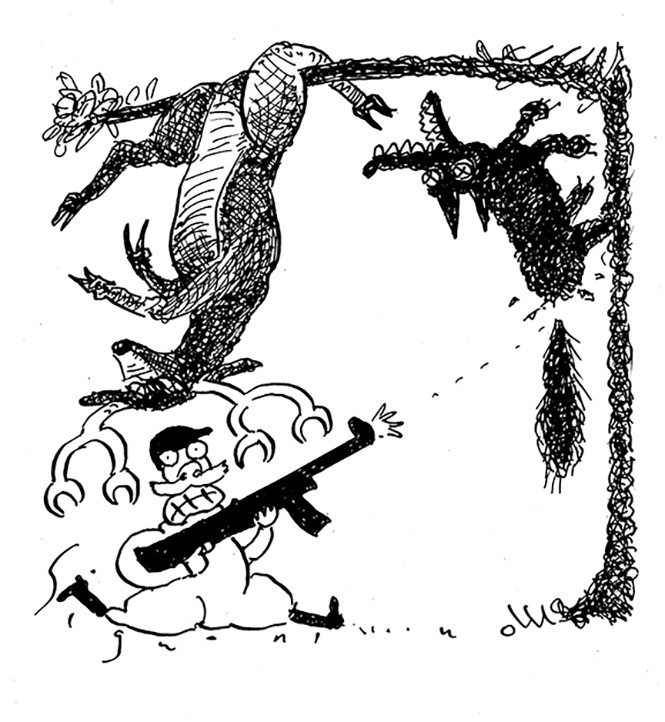
- SLUG SIGNORINO
Are there extinct species that we really wish we hadn't wiped out? I don't mean we now say, "Gee, what a shame." I mean, is there anything where we now say, "Oh $#!&, we screwed ourselves!"? Like when the Chinese thought getting rid of all the sparrows was a good idea.
—Lumpy, via the Straight Dope Message Board
If you're not as up on your People's Republic history as Lumpy here, allow me to read you in. Having become concerned about sparrows eating the grain Chinese farmers were growing, in 1958 Mao ordered the birds' extermination, and an estimated billion of them were killed. Problem was, those sparrows had also been eating locusts that liked to eat grain themselves, and with nothing keeping them in check, the bugs commenced to eat the fields bare. Together with various other agricultural policies of the Great Leap Forward, the sparrow campaign helped lead to the starvation deaths of tens of millions of people; as far as history's gravest unintended consequences go, this one's in the hall of fame. And as Lumpy suggests, it's a particularly vivid illustration of how humans can bollocks up a functioning ecosystem by intervening without thinking through the bigger implications.
Are there others? Sure. Turn your attention to present-day India, where since just the early '90s three once-abundant species of vulture have all but died off—officially, they're critically endangered, but according to some scientists they're "functionally extinct." This one's on us, too: the birds were feeding on the decaying flesh of cows that Indian farmers had fed with a particular painkiller, diclofenac. In cows it soothed aching hooves; in vultures it led to fatal kidney failure.
Appearance wise, vultures don't do much to pretty up a biome, true, but in south Asia their carrion-eating was a vital public service. Remember, these are birds that can put away an anthrax-infected carcass and go back for more. (Pity they couldn't handle a common NSAID.) This made them a reliable firebreak between humans and some major infectious diseases, including tuberculosis and rabies, whereas the less hardy rats and wild dogs that have taken over the carrion gig tend to spread these around. With vultures on the ropes, India faces a public-health disaster.
So far we've yet to mention an animal that's been wiped out altogether, but don't get too hung up on extinction per se. Sure, the disappearance of the last member of a species is a grim milestone. The consequential problem, though, is a species' general disappearance from an ecosystem, even if a few individuals keep on keeping on. Just a modest decline in the populations of key creatures can screw things up, and a steep drop can be devastating; however circuitously, those effects will come back to bite us. For instance:
• In the late 1880s, Italian army livestock in East Africa introduced a highly lethal bovine disease called rinderpest: it devastated sub-Saharan herbivores from pigs to wildebeest, and starved a lot of people who relied on cattle for food, nomadic herders and colonial farmers alike. The deaths of all those grazers and browsers also led to a steep growth in plant biomass, leading to a century of worse and more frequent wildfires—leading in turn to property damage, fire-suppression costs and tons of carbon dumped into the atmosphere.
• These days, sub-Saharan Africa is contending with the decline of its apex predators via hunting, habitat loss, etc. Fewer lions and leopards means, among other things, more olive baboons, who've encroached further into human territory, bringing competition for food and an uptick in intestinal parasites for both the humans and the baboons. This isn't the worst to come out of the complex relationship between food chain and disease on that continent: Industrial overfishing in the Atlantic has led West Africans to increasingly seek other protein sources, including primate bushmeat. If you'll recall, eating chimp flesh is thought to be the conduit through which HIV found its way to humans, and there are other scary primate viruses out there ready to make their move.
• In the centuries since wolves were hunted out of the British Isles, deer have become rampant in the UK. With their numbers now at a thousand-year high, they're responsible for some 50,000 traffic accidents annually, plus they impede forest regeneration by eating all the seedlings. The animals represent such a pain in Britain's ass that there's a project afoot (inspired by a successful initiative at Yellowstone) to bring back the wolves.
One hears a lot about how we're in the midst of a mass extinction, the sixth in history. Ecologists believe that losing large carnivores will be the really big deal here, setting in motion the follow-on effects seen above: more fires, invasive species, carbon pollution, agricultural problems, infectious diseases, and on and on—widespread ecosystem malfunction that reconfigures the whole food chain, and whose costs to us keep compounding over time. The technical name for this process is "trophic cascading," but I can think of more colloquial phrases that might work here too—"You break it, you bought it," for one.
Send questions to Cecil viastraightdope.comor write him c/o Chicago Reader,30 N. Racine, Ste. 300, Chicago, Ill., 60607.